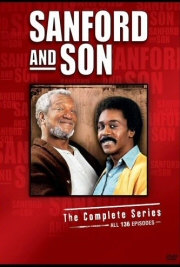 With the temperature dropping, it's time to find someone to keep you warm. Find your hookups with our online dating guide!
With the temperature dropping, it's time to find someone to keep you warm. Find your hookups with our online dating guide!
The Complete Series
- Comedy
- 2008
- Buy the DVD
Reviewed by Ross Ruediger
()
he ‘70s produced some of the best and most groundbreaking sitcoms ever created, and writer/producer Norman Lear was at the helm of a number of them, including “All in the Family,” “Maude,” “The Jeffersons” and “One Day at a Time.” As much fun as something like “That 70s Show” is, there’s really no substitute for actually watching a series created in that time period in order to have a better understanding of the social climate of the time. One of Lear’s most irreverent efforts was “Sanford and Son,” which, like “All in the Family” before it, was a remake of a British series. Also like “Family,” it set out to showcase the blue-collar point of view of a guy whose outlook was so outrageous in its simplicity that you had no choice but to love him. That guy was Fred Sanford, a junk dealer operating out of his home in south Los Angeles, and he was played by comedian Redd Foxx so successfully that he never really escaped the role in the years after the show went off the air.
As the title implies, Sanford lives with his only son, Lamont (Demond Wilson), and his wife Elizabeth passed away some 20 years prior. The grumpy, close-minded old timer Sanford and his somewhat more progressive offspring are continually at odds with one another, even though they clearly need one another to survive. The Sanfords are dirt poor, and in one episode it’s revealed that between the two of them they only make $7,000 a year – and $3,000 of that comes from Fred’s social security checks. And yet because this is a sitcom, and despite their continued failed efforts to try to better their lives, there’s really no tragedy to be seen here. They don’t get depressed about their surroundings, but instead seem to live with an eternal hope that life will one day turn around for them. Thing is, it never really does, and the show more or less ended (after six seasons) in the same hopeless place it began. If you’ve never seen “Sanford and Son,” it’s probably difficult to believe such material could be riotously funny, and yet you must believe me when I say that it is.
A huge part of the gimmick relies on insult humor, and Foxx delivers one zinger after another from each installment to the next, many of which are directed at his Bible toting and quoting sister-in-law, Esther (LaWanda Page, playing an ideal comic foil). Often times the insults aren’t nearly as funny as Foxx’s delivery. An ongoing gag involves him calling Lamont a dummy, which you’d think would get old after a couple episodes, and yet it never really does. It’s the kind of comfortable punchline that you begin to see coming, and eventually start to count on for an easy laugh. The show is also remarkably candid with its racial slurs. There’s stuff that comes out of Foxx’s mouth that would never be uttered on television today, and indeed the episodes have been sometimes cut for content in syndication (although that’s not the case here). See the episode “Fred Sanford, Legal Eagle” for a shockingly gut-busting scene that liberally uses the n-word, which sort of proves my point: I can’t in good conscience type the word Foxx had so much fun with on primetime TV back in the mid-70s. But he’s an equal opportunity offender, and no race goes unpunished in this show at some time or another. The show has an almost addictive quality to it, and once you start spinning episodes, it’s difficult to stop, especially with a set like this. Even my 15-year old, who I thought for sure would tire of Foxx’s antics after a few episodes, has been taking the set off to his room to watch it on his own. Skinny white skater kid digging on the crusty old black dude – what higher compliment can the show be given?
The quality remains reasonably high throughout the entire run, although the last couple seasons do see the occasional heart-warming moment that never would’ve been played earlier in the run. In the final season there’s even an episode where Sanford meets Foxx himself when trying to win a Redd Foxx lookalike contest, which sort of shows how gimmicky it got from time to time near the end. The episode isn’t as cool as it sounds, but that may be due in part to the terrible split-screen effect used.
Special Features: The set uses the same type of packaging that Jeff Giles described in his “NewsRadio” review, so I won’t rehash that information, but I would like to add that if Sony is going to continue repackaging series like this, they should at least use a thicker, more durable type of plastic for the spindle inside. The piece that’s in there is about as thick as the cheap stuff you find inside a package of Ding Dongs. Unlike “Newsradio,” however, this is a bare bones set. You won’t find any extras here.
You can follow us on Twitter and Facebook for content updates. Also, sign up for our email list for weekly updates and check us out on Google+ as well.











